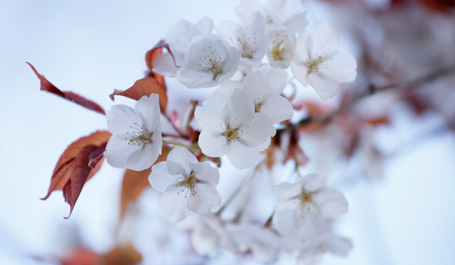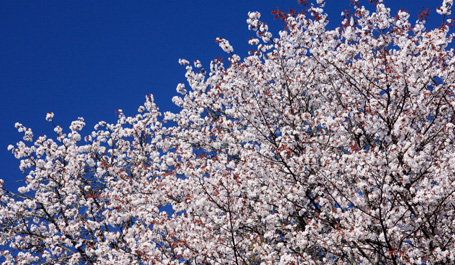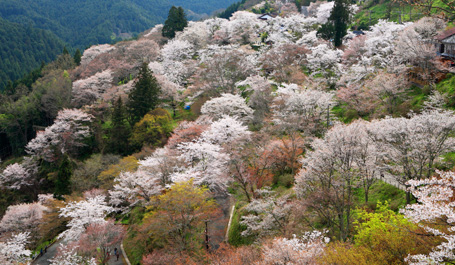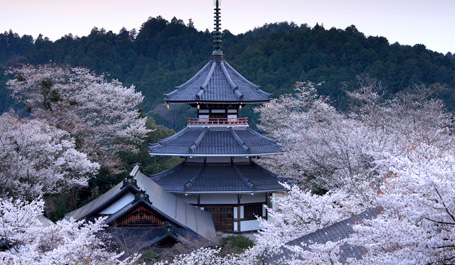MENU





(Characteristics)
Most cherry trees in Yoshino belong to the Shiroyamazakura species characterized by red leaves that appear prior to the blossoms.


(Origins)
It is said that the cherry trees in Yoshino have been worshiped and cultivated as sacred trees since about 1300 years ago when Enno Gyoja, founder of the Shugendo traditional religion, carved the mountain deity Zaou-Gongen from a mountain cherry tree.
Over this time, the people of the region have continued to revere the trees.
There are said to be 30,000 of the trees growing today, the majority of which are Shiroyamazakura.
Yamazakura are the dominant species growing in the wild in Japan, and in contrast to the Someiyoshino variety of cherry tree created for ornamental use during the Edo period, they are known for being long-lived and growing to a large size.

| 671 | Enno Gyoja is said to have encountered the mountain deity Zaou-Gongen on Kinpusen (Mount Ōmine) and made a carving out of a cherry tree. |
|---|---|
| 701 | The Empress Jitou made thirty-two pilgrimages to Yoshino up to this year. |
| 900 | Emperor Uda visited Kinpusen during this year and in 905. |
| 960 | The Emperor's residence burned down. Subsequently, a Mount Yoshino cherry tree, called the Sakon no Sakura, was planted in front of the Shishinden (a hall for state ceremonies). Up until this time, there was a "Kanenomitake" legend of buried gold on Kinpusen. |
| 1007 | Fujiwara Michinaga made a pilgrimage to Kinpusen and built a sutra mound on the mountain. |
| 1049 | Pilgrimage by Fujiwara Yorimichi |
| 1092 | Pilgrimage by Emperor Shirakawa |
| 1140 | Taira No Tadamori donates a bell (the Saburo bell, an important cultural property) to Kinpusen. Around this time, Saigyo came and stayed for a time at the temple. |
| 1185 | Minamoto No Yoshitsune and his associates flee to Mount Yoshino. His concubine, Shizuka Gozen, is caught and sent to Kamakura. |
| 1226 | Statue of Zaou-Gongen at Nyoirin-ji Temple constructed (an important cultural property). |
| 1251 | Statue of Tamayorihime-no-mikoto at Mikumari-Jinja constructed (a national treasure). |
| 1332 | Prince Moriyoshi builds castle at Yoshino and raises an army to overthrow the shogunate. |
| 1333 | Kamakura Bakufu attacks and Prince Moriyoshi's forces take refuge in Mount Koya. Murakami Yoshiteru and Yoshitaka (father and son) die in battle. Most of Mount Yoshino's forest is burnt down. |
| 1336 | Emperor Go-Daigo secretly visits Mount Yoshino. The period of conflict between the Northern and Southern dynasties of Japan begins. Kissuiin Soshin's people welcome Emperor Go-Daigo and designate Kissuiin (what is now the Yoshimizu shrine) as a temporary imperial residence. Later Jitsujoji (Kinrinnoji) temple is designated an imperial residence. |
| 1338 | The guardian god of the Nio Mon gate (a national treasure) is constructed (an open-mouthed statue that is a prefectural treasure). |
| 1339 | Emperor Go-Daigo dies. Buried at Tonoo-san (at the rear of the main temple building of Nyoirin-ji). The guardian god of the Nio Mon gate is constructed (a closed-mouthed statue that is a prefectural treasure). |
| 1347 | Kusunoki Masatsura makes final palace visit to farewell Emperor Go-Murakami and pay his respects to the tomb of Emperor Go-Daigo prior to departing for the Battle of Shijonawate. |
| 1348 | Attack by Ashikaga army led by Ko no Moronao causing Emperor Go-Murakami's court to flee to Ano (Nishi-Yoshinomura). Most of Mount Yoshino's forest is burnt down. |
| 1471 | Copper lantern in front of Zao-do Hall (an important cultural property) donated. |
| 1553 | Sanjonishi Kineda visits and writes "Yoshino-moude-ki". |
| 1578 | Sueyoshi Kanbe, a wealthy merchant of Setsu Hirano, gifts ten-thousand cherry tree seedlings. From this time on, numerous people making a pilgrimage plant cherry trees as a gift. |
| 1592 | Zao-do Hall (a national treasure) is rebuilt in its current form around this time. |
| 1594 | Toyotomi Hideyoshi brings a group including Toyotomi Hidetsugu, Tokugawa Ieyasu, Maeda Toshiie, and Date Masamune to Yoshino for a major hanami gathering (blossom viewing). |
| 1595 | Toyotomi Hideyoshi confers shogunate license to trade on Kinpusen-ji. |
| 1604 | Toyotomi Hideyori restores Mikumari Shrine (an important cultural property), Anzen-ji (abandoned temple), Ohashi, and others. From this time on, mountain visits (to Mount Ōmine) by common people become increasingly frequent. |
| 1874 | Zao-do Hall and others forcibly turned into a shrine under policy of separating Buddhism and Shintoism. |
| 1886 | Zao-do Hall restored as a Buddhist temple. |
| 1924 | Mount Yoshino designated a historic landmark and place of scenic beauty. |
| 1928 | Railway extended to present-day Yoshino Station. |
| 1936 | Yoshino-Kumano National Park established. |
| 2004 | "Sacred Sites and Pilgrimage Routes in the Kii Mountain Range" designated a UNESCO World Heritage site. |